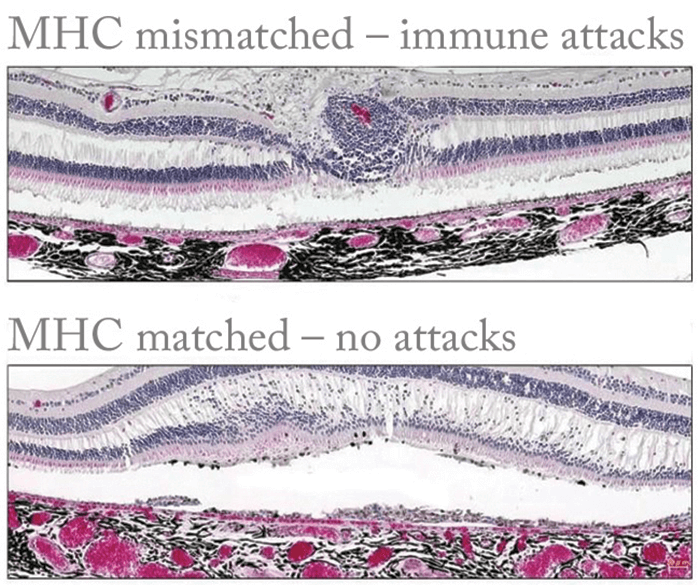
Ophthalmic research has been at the forefront of the drive for clinical translation, and the use of human induced pluripotent stem cells (iPSCs) for the treatment of retinal disease like AMD is a striking example of this. You can take, say, a skin epithelial cell, induce pluripotency, and soon you have a self-renewing reservoir of cells that can be differentiated into almost every cell type, including RPE, which can then be implanted to try and treat disease. However, there’s a very practical problem: the high cost. The use of allogeneic – human, but genetically and immunologically dissimilar – stem cells could help reduce that cost burden; you could order RPE from an iPS cell bank. But this raises the issue of graft rejection. These cells will go on to express the wrong major histocompatibility complex (MHC) antigens, and the immune system kicks in to play.
Figure 1. The results of transplanting of MHC-matched or -mismatched allografts using iPSC-derived RPE cells (iPS-RPE) established from a MHC homozygote donor (1). Credit: Sunao Sugita.
Now, Sugita et al., (1) have, in cynomolgus monkeys, shown that you can successfully use allogeneic iPSC-derived RPE cells, without immunosuppression, so long as those iPSCs come from a MHC-matched donor (Figure 1). If the iPSCs came from a MHC-mismatched donor, as expected, the immune system was unleashed: the RPE exhibited inflammatory and hypertrophic changes, and many inflammatory cells invaded the graft area, such as Iba1+ cells, MHC class II+ cells, and CD3+ T cells. The authors concluded that “cells derived from MHC homozygous donors could be used to treat retinal diseases in histocompatible recipients.” Where to now? The study’s lead author explained, “In our next clinical trial, we plan to use allogeneic iPS-RPE cells from HLA homozygote [matched] donors. The clinical data after the transplantation will allow us to see if the iPS cell bank is truly useful or not. If so, I think this type of transplantation can become [the] standard treatment within five years.”
References
- S Sugita et al., “Successful transplantation of retinal pigment epithelial Cells from MHC homozygote iPSCs in MHC-matched models”, Stem Cell Reports, [Epub ahead of print] (2016). PMID: 27641649.
